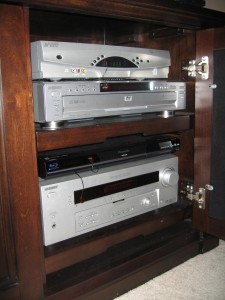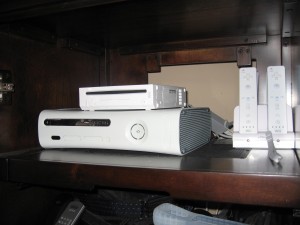Today I received notification that I passed my CISSP exam.  I still am not an offical CISSP since there are other requirements apart from passing the exam.  So for now I’m an “Associate of (ISC)2″….I will be taking Security+ soon and in February I should be an official CISSP.
Took me awhile to get what should have been a simple Linux P2V done at work!
This stuff wasn’t clearly stated anywhere–I couldn’t find anyone with similar issues, so I’m posting this up hoping to help someone else out in the future. Â Working with VMware they pointed out the lack of support for dvSwitches after passing through a few levels of support their.
Error: Unable to connect to the Converter helper server on the target virtual machine
Cause: VMware does not support the usage of dvSwitches for Linux Conversions! Â Make sure the network you select isn’t a dvSwitch
Error: Unable to obtain the IP address of the target virtual machine running the Converter helper server.
Cause: Related to the above error, relying on DHCP while using a network that is a dvSwitch for a conversion will get you the above error.
FAILED: MethodFault.summary
The last task before removal will be something like: Connecting the Converter helper ISO image to the target virtual machine.
Cause: ESX(i) 4.1 is not supported at this time by VMware Converter–this was with version 4.0.1–the latest version at the time this post was made.
Leave a comment if these notes helped you out or if you have any other uncommon errors you ran into.
Ever wanted to exhaust a DHCP servers pool? (of course for testing things in a non-production environment)
I did, so I created DHCP Pwnage
This Perl script will grab as many leases as you want, you define the number of leases via the $ClientC var. I plan on writing this tool in PHP so I can add a lot more functionality.
This was created by modifying the example code of Net::DHCPClientLive, to get Net::DHCPClientLive you will need to force the install or notest the install via CPAN. I have had no luck having Net::DHCPClientLive install properly on any platform without using force or notest.
Download: dhcp-pwnage-v0.1.pl.zip
Something cool for your ESX/ESXi labs–Rather then relying on using the VIC (VMware Infrastructure Client) to remote control your VMs you can enable VNC access to them.
To do this power off the VM and add the lines below to the VMs .vmx file, you will need to choose a different port for each VM you wish to do this on.
remotedisplay.vnc.port=â€5900″
remotedisplay.vnc.enabled=â€trueâ€
If your using ESX you can password protect the VNC connection by adding this line:
remotedisplay.vnc.password = “passwordâ€
// =============================================// getmac(Device IP, Router, SNMP Read Community)// Â Michael Requeny — http://michael.requeny.com// – Looks up remote devices MAC// – SNMP to routers ARP table// – Converts MAC from HEX to ASCII// – Inserts : seperators// =============================================function getmac($ip, $router, $snmpread) {$oid = “.1.3.6.1.2.1.3.1.1.2”;$mac = snmprealwalk($router, $snmpread, $oid, 1000000 ,10);// load up array keys for lookups$keys = array_keys($mac);foreach ($keys as $key) {// if needle contains IP && needle = IP// this prevents srch for 10.254.254.1 returning// multiple values (like .1, .11, .111, etc.if (strstr($key,$ip) == $ip) {$mackey = $key;}}$mac = trim(str_replace(‘Hex-STRING: ‘, ”, $mac));$mac = str_replace(‘ ‘, ‘:’, $mac);return $mac;}
So you want to setup a card access system? Well assuming you don’t mind being locked out of your home for a few hours here is how it’s done…
First let’s cover how they work—
There are five parts to a card access system:
- Control Interface
- Cards
- Readers (Either card readers, keypads, or a combination of both)
- Card Access Control Panel(s)
- Outputs (electromagnetic locks, electric strikes, contacts) Read the rest of this entry »
So this was a challenge–I wanted to eliminate the X10 remote and disable X10 on my INSTEON switches for the home theater. In doing so I wanted to use the INSTEON IRLinc to convert IR signals to INSTEON. This would allow me complete control via my Logitech Harmony Remote.
I hooked up the IRLinc and paired up my devices to Scenes A/B and everything worked fine with the IRLinc credit card remote. To get the Harmony setup I had to add custom commands for Scene A on/off (Screen Up/Down) and Scene B on/off (Wall Scones on/off). These had to be learned on the Harmony using the IRLinc remote when I was done I quickly discovered control from the Harmony was very unreliable. I toyed with this for a few days on and off and eventually got fed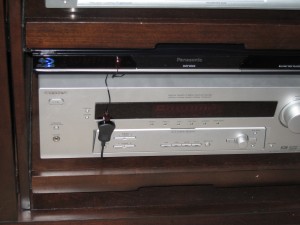 up and tossed it in a drawer to forget about.
up and tossed it in a drawer to forget about.
Last night Ken was over and I decided to have two minds look at it 😛 I knew it should work, and with a fresh pair of eyes we got it working. We hooked it up and everything worked properly–I had previously added the INSTEON switches to the IRLinc’s scenes and it had retained those settings. Testing it with the IRLinc’s credit card remote everything worked fine (as before) but with control via Harmony was very unreliable just as before. We tried relearning the IR signals and that wasn’t getting us anywhere while sitting there staring at the screen we saw the “Custom” button on the IR Learn page in the Harmony software. When we hit that we saw that all our learned commands had “Analyzed” next to them so we hit the new Learn Raw button that appeared once we hit the Custom button. The learning process was a lot faster and we quickly updated the remote to test. Success! We learned that the Harmony doesn’t replicate IR codes it learns exactly. By default the remote analyzes the IR signal and fixes any issues or interferance it encounters (sunlight in the room for example has IR light). When the Harmony analyzed the IRLinc’s signal it would clean the signal so much to the point that the IRLinc wasn’t able to respond because it wasn’t receiving the proper IR signal. Hopefully this post helps others who have IRLinc’s in drawers from failed integration with Harmony remotes.
We mounted the IRLinc’s receiver on the front of my A/V receiver since I have no spare IR Emitters. I don’t think I’ll even pickup another IR emitter for this since it’s always behind a closed door.
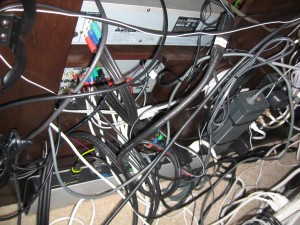 I was out of outlets so and saw an APC A/V power conditioner for super cheap–it has 10 or 12 outlets. While I was swapping out the old strip (6 outlets) for this one I cleaned up the cables some–yes this is much much better then before. I’ve got 0 outlets to spare. I may have to add a second duplex outlet on the wall to accommodate my IR to Insteon device, it has a pass-through plug but I don’t trust running much through it and it takes up an entire duplex outlet–due to the APC conditioner using a low profile plug….
I was out of outlets so and saw an APC A/V power conditioner for super cheap–it has 10 or 12 outlets. While I was swapping out the old strip (6 outlets) for this one I cleaned up the cables some–yes this is much much better then before. I’ve got 0 outlets to spare. I may have to add a second duplex outlet on the wall to accommodate my IR to Insteon device, it has a pass-through plug but I don’t trust running much through it and it takes up an entire duplex outlet–due to the APC conditioner using a low profile plug….
Power Cables:
- Power Bridge (Feeds PJ and TV)
- Receiver
- DVD Player
- Blu-Ray Player
- Cable Box
- Wii
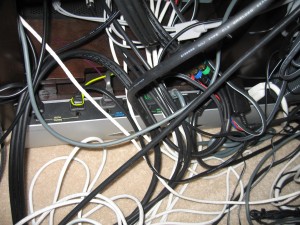
- Xbox 360
- 2 Wiimote Chargers
- HDMI Splitter
- IR Connecting Block
- Harmony Remote Charger
- Cordless Phone Charger
- 2 Lamps
I know it needs more work, I plan to bundle up the speaker cables, but other then that there are only a couple of other things I can think of doing to improve this. All the power cables are bundled near the back of the respective component already…
Just picked up a Blu-Ray player on sale @ Amazon (Panasonic DMP-BD60) and now not having an HDMI capable receiver is starting to suck. Swapping cables between Xbox, Bluray and Cable for the PJ really blows. Looking at some Onkyos but can’t make up my mind.  Having to take into account our Zone 2 audio (patio) makes it a bit more difficult. The receivers I’m looking at have a limitation of only being able to send non-HDCP audio to Zone 2–therefore I will have to retain an older DVD player for this…going to be running out of room in the media cabinet quickly now.

